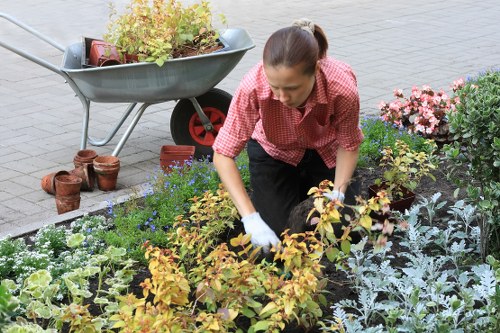Enhancing Lawn Turf Installation with Jet Washing Techniques
Introduction to Jet Washing in Turf Installation

When it comes to lawn turf installation, achieving a pristine and healthy lawn begins long before the turf is laid down. One critical step often overlooked is jet washing, a process that ensures the ground is perfectly prepared for optimal turf growth. Jet washing, also known as power washing, utilizes high-pressure water streams to cleanse the soil, removing debris, contaminants, and old vegetation that could hinder new turf establishment.
Proper jet washing not only prepares the soil but also enhances the overall quality of the lawn by creating an ideal environment for the turf to take root and thrive. This method is increasingly popular among homeowners and landscapers alike due to its efficiency and effectiveness in preparing large areas swiftly.
In this article, we'll delve into the various aspects of jet washing in lawn turf installation, exploring its benefits, the step-by-step process, and tips to ensure successful turf establishment.
Benefits of Jet Washing in Lawn Turf Installation

Incorporating jet washing into your turf installation process offers numerous advantages:
- Enhanced Soil Quality: Removes weeds, rocks, and debris, ensuring a smooth surface for turf laying.
- Improved Water Drainage: Clears existing blockages, allowing for better water permeability and reducing the risk of waterlogging.
- Pest Control: Eliminates pests and their remnants, preventing future infestations that could damage the new turf.
- Time Efficiency: Covers large areas quickly, saving time compared to manual soil preparation methods.
These benefits collectively contribute to a more resilient and aesthetically pleasing lawn, making jet washing a valuable step in the turf installation process.
Step-by-Step Guide to Jet Washing for Turf Installation

Executing a successful jet washing procedure involves several meticulous steps:
- Assessment: Evaluate the area to identify the extent of cleaning required and any potential obstacles.
- Preparation: Remove any movable objects, furniture, or obstacles from the lawn area to prevent damage during washing.
- Equipment Setup: Choose the appropriate jet washing equipment based on the size of the area and the nature of the soil.
- Application: Systematically apply high-pressure water to cleanse the soil, focusing on areas with stubborn debris or contaminants.
- Inspection: After washing, inspect the area to ensure complete cleanliness and suitability for turf installation.
- Final Preparation: Make any necessary adjustments to the soil, such as leveling or adding topsoil, before laying the turf.
Following these steps ensures that the ground is optimally prepared, facilitating successful turf growth and longevity.
Choosing the Right Jet Washing Equipment

Selecting the appropriate jet washing equipment is crucial for effective soil preparation. Consider the following factors:
- Pressure Levels: Ensure the equipment can deliver sufficient pressure to remove stubborn debris without damaging the soil structure.
- Nozzle Types: Various nozzles offer different spray patterns; choose one that suits your cleaning requirements.
- Mobility: For larger areas, mobile jet washers are more efficient, while smaller, portable units suffice for confined spaces.
- Water Supply: Ensure a consistent and adequate water supply to maintain continuous operation during the cleaning process.
Investing in high-quality jet washing equipment tailored to your specific needs will result in a more effective and efficient soil preparation process.
Environmental Considerations of Jet Washing

While jet washing is highly effective, it's essential to consider its environmental impact:
Water Usage: Jet washing can consume significant amounts of water. Implementing water-efficient practices, such as recycling water or using low-flow nozzles, can mitigate this effect.
Soil Health: Excessive use of high-pressure water may lead to soil erosion. It's vital to balance cleaning efficiency with the preservation of soil integrity.
Chemical Runoff: If using cleaning agents, ensure they are environmentally friendly to prevent contamination of local water sources.
By adhering to sustainable practices, jet washing can be performed in an eco-friendly manner, preserving both the lawn and the surrounding environment.
Best Practices for Jet Washing in Turf Installation
To maximize the benefits of jet washing in turf installation, consider the following best practices:
- Timing: Perform jet washing during dry weather to ensure optimal soil conditions and prevent waterlogging.
- Regular Maintenance: Keep your jet washing equipment well-maintained to ensure it operates efficiently and effectively.
- Proper Training: Ensure that operators are adequately trained to handle the machinery, preventing accidents and ensuring high-quality results.
- Soil Testing: Conduct soil tests post-washing to assess nutrient levels and pH balance, making necessary amendments before turf installation.
Implementing these practices ensures that the jet washing process contributes positively to the health and appearance of your new turf.
Integrating Jet Washing with Other Soil Preparation Methods
While jet washing is highly effective, integrating it with other soil preparation techniques can yield even better results:
- Soil Aeration: Aerating the soil after jet washing improves oxygen flow, promoting healthy root growth.
- Topsoil Addition: Adding nutrient-rich topsoil can compensate for any erosion caused during jet washing and provide essential nutrients for turf growth.
- Seed Pre-Planting: In cases where turf isn’t being laid directly, seeding the prepared soil can lead to a more uniform and resilient lawn.
Combining jet washing with these methods ensures a comprehensive approach to soil preparation, setting the foundation for a lush and enduring lawn.
Cost-Effectiveness of Jet Washing
Investing in jet washing can be cost-effective in the long run:
By ensuring thorough soil preparation, the likelihood of turf failure due to poor soil conditions decreases, saving costs associated with reinstallation or lawn repair. Additionally, the efficiency of jet washing reduces labor time, translating to lower overall installation costs.
Comparatively, manual soil preparation methods are labor-intensive and time-consuming, often resulting in higher expenses. Jet washing offers a swift alternative without compromising quality, making it a financially sound choice for both homeowners and landscaping professionals.
Case Studies: Success Stories with Jet Washing
Numerous projects have benefited from incorporating jet washing into their turf installation processes:
Residential Lawn Transformation
A homeowner in Texas faced persistent weed problems and uneven soil. By employing jet washing, the old debris and weeds were effectively removed, and the soil was leveled. Post-installation, the lawn achieved a uniform appearance with robust turf growth.
Commercial Landscaping Project
A commercial property in Florida utilized jet washing for their expansive lawn areas. The process significantly reduced labor time and costs while ensuring a clean and ready substrate for turf installation. The result was a lush, green landscape that enhanced the property's aesthetic appeal.
These examples highlight the practical benefits and successful outcomes achieved through the integration of jet washing in turf installation.
Choosing the Right Professionals for Jet Washing
To maximize the effectiveness of jet washing, it's essential to engage experienced professionals:
- Expertise: Professionals possess the knowledge to assess soil conditions and determine the appropriate jet washing techniques.
- Equipment: They have access to advanced jet washing machinery, ensuring thorough and efficient cleaning.
- Safety: Trained technicians adhere to safety protocols, minimizing risks during the jet washing process.
Selecting reputable and skilled jet washing services guarantees high-quality soil preparation, paving the way for a successful lawn turf installation.
Maintenance Tips Post Turf Installation
Once the turf is installed, maintaining its health ensures longevity and continued beauty:
- Proper Watering: Ensure the turf receives adequate water, especially during the initial growth phase.
- Mowing Practices: Regular mowing at appropriate heights encourages dense and healthy growth.
- Fertilization: Apply fertilizers as needed to replenish soil nutrients and promote vigorous turf development.
- Pest Management: Monitor for pests and address infestations promptly to prevent damage.
Implementing these maintenance practices ensures that the benefits of jet washing and turf installation are sustained over time, resulting in a vibrant and resilient lawn.
Long-Term Benefits
Investing in jet washing not only facilitates immediate soil preparation but also contributes to long-term lawn health. A well-prepared soil base enhances nutrient uptake, root growth, and overall turf resilience against environmental stressors.
Common Mistakes to Avoid
To ensure the success of your turf installation, be mindful of the following common pitfalls:
- Overusing Pressure: Excessive pressure can damage the soil structure and compromise turf roots.
- Neglecting Soil Testing: Failing to assess soil composition post-washing may overlook deficiencies affecting turf health.
- Improper Timing: Performing jet washing during inappropriate seasons can lead to poor soil conditions and turf establishment.
Avoiding these mistakes enhances the effectiveness of jet washing and supports the successful growth of your new lawn.
Environmental Sustainability
Embracing sustainable jet washing practices aligns with eco-friendly landscaping:
Recycling Water: Implement systems to recycle water used in jet washing, reducing waste and conserving resources.
Biodegradable Cleaners: Use environmentally benign cleaning agents to prevent soil and water contamination.
Minimal Disturbance: Adjust jet washing techniques to minimize soil disruption, preserving soil structure and biodiversity.
By prioritizing sustainability, jet washing becomes a responsible choice for soil preparation, benefiting both your lawn and the broader environment.
Future Trends in Jet Washing for Turf Installation
The landscape of jet washing is evolving with advancements in technology and sustainability:
- Smart Jet Washers: Integration of IoT and automation enhances precision and efficiency in soil cleaning processes.
- Eco-Friendly Solutions: Development of greener jet washing technologies reduces environmental impact.
- Multi-Functional Equipment: Versatile jet washers capable of handling diverse landscaping tasks streamline turf installation workflows.
Staying abreast of these trends ensures that turf installation practices remain effective, efficient, and environmentally responsible.
Embracing innovative jet washing solutions paves the way for superior lawn quality and sustainable landscaping practices.
Conclusion
Incorporating jet washing into lawn turf installation is a strategic move that significantly enhances soil preparation, paving the way for a lush and healthy lawn. By understanding its benefits, following best practices, and selecting the right professionals, homeowners and landscapers can achieve outstanding results.
Moreover, adhering to environmental sustainability ensures that turf installation contributes positively to both your immediate surroundings and the broader ecosystem.
Ready to transform your lawn with professional jet washing services? Contact us today to schedule your turf installation and experience the difference jet washing can make!
FAQs About Jet Washing in Turf Installation
Is jet washing suitable for all types of soil?
While jet washing is effective for most soil types, it's essential to assess soil composition beforehand. Extremely clay-heavy or sandy soils may require specialized jet washing techniques to achieve optimal results.
How often should jet washing be performed before turf installation?
It's typically a one-time process performed immediately before turf installation. However, if maintaining an existing lawn, periodic jet washing can help remove debris and prevent weed growth.
Can jet washing damage the underlying soil?
When performed correctly, jet washing should not damage the soil. It's crucial to use the appropriate pressure settings and techniques to preserve soil structure and fertility.
Get Started with Jet Washing Today
Don't let poor soil conditions hinder your dream lawn. Jet washing offers a reliable solution to prepare your ground for successful turf installation. Whether you're a homeowner aiming for a beautiful backyard or a professional landscaper managing large projects, jet washing can significantly enhance your turf installation outcomes.
Book your service now and take the first step towards a greener, healthier lawn!